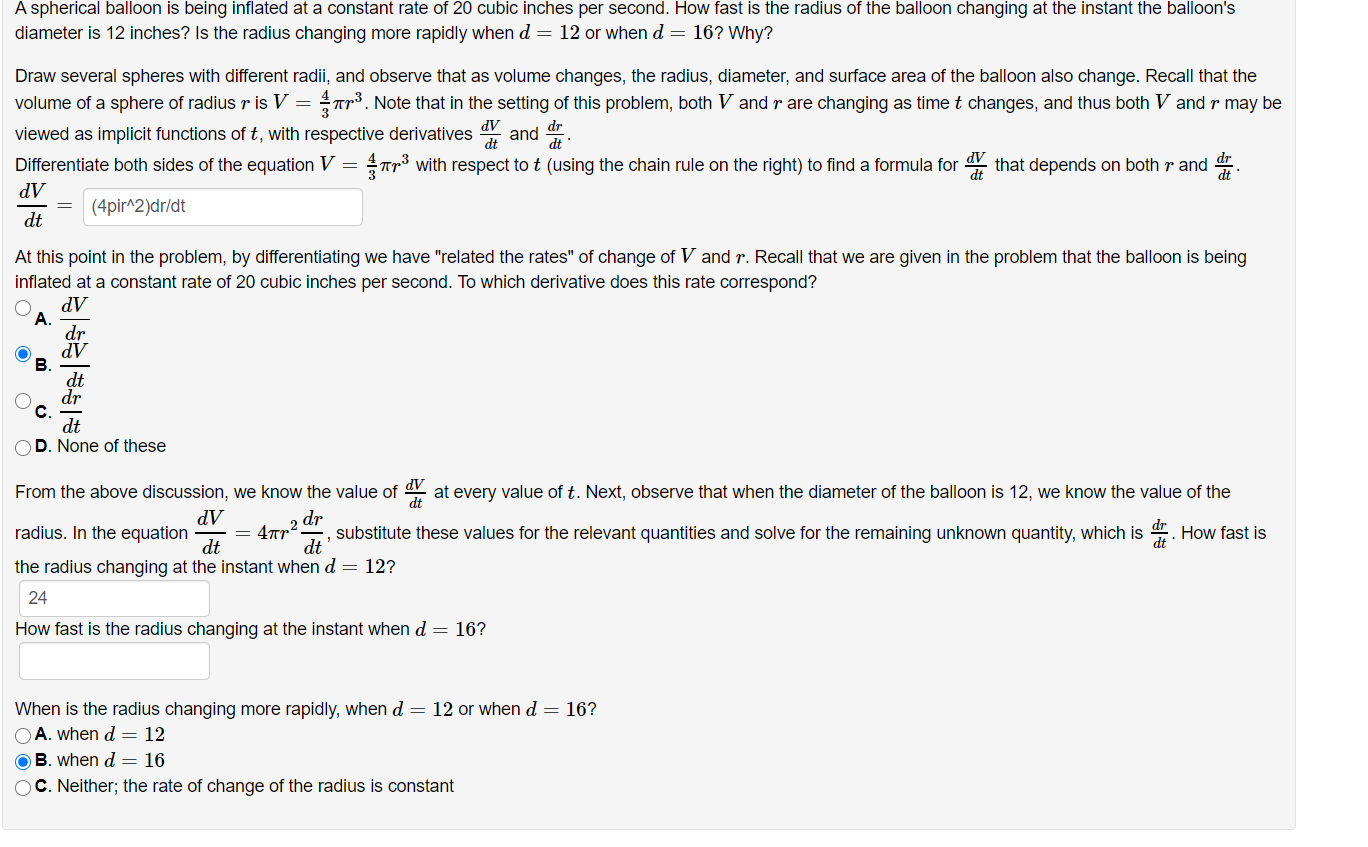A spherical balloon is being inflated at a constant rate of 20 cubic inches per second. How fast is the radius of the balloon changing at the instant the balloon's diameter is 12 inches? Is the radius changing more rapidly when d = 12 or when d = 16? Why? Draw several spheres with different radii, and observe that as volume changes, the radius, diameter, and surface area of the balloon also change. Recall that the volume of a sphere of radius r is V = Tr³. Note that in the setting of this problem, both V and r are changing as time t changes, and thus both V and r may be viewed as implicit functions of t, with respective derivatives AP and dt dt · Differentiate both sides of the equation V = Tp³ with respect to t (using the chain rule on the right) to find a formula for that depends on both r and 4. %3D dV (4pir^2)dr/dt dt At this point in the problem, by differentiating we have "related the rates" of change of V and r. Recall that we are given in the problem that the balloon is being inflated at a constant rate of 20 cubic inches per second. To which derivative does this rate correspond? AP dr AP dt dr с. dt D. None of these From the above discussion, we know the value of d at every value of t. Next, observe that when the diameter of the balloon is 12, we know the value of the AP radius. In the equation dr substitute these values for the relevant quantities and solve for the remaining unknown quantity, which is . How fast is dt the radius changing at the instant when d = 12? dt 24 How fast is the radius changing at the instant when d = 16? When is the radius changing more rapidly, when d = 12 or when d = 16? OA. when d = 12 OB. when d = 16 OC. Neither; the rate of change of the radius is constant
Addition Rule of Probability
It simply refers to the likelihood of an event taking place whenever the occurrence of an event is uncertain. The probability of a single event can be calculated by dividing the number of successful trials of that event by the total number of trials.
Expected Value
When a large number of trials are performed for any random variable ‘X’, the predicted result is most likely the mean of all the outcomes for the random variable and it is known as expected value also known as expectation. The expected value, also known as the expectation, is denoted by: E(X).
Probability Distributions
Understanding probability is necessary to know the probability distributions. In statistics, probability is how the uncertainty of an event is measured. This event can be anything. The most common examples include tossing a coin, rolling a die, or choosing a card. Each of these events has multiple possibilities. Every such possibility is measured with the help of probability. To be more precise, the probability is used for calculating the occurrence of events that may or may not happen. Probability does not give sure results. Unless the probability of any event is 1, the different outcomes may or may not happen in real life, regardless of how less or how more their probability is.
Basic Probability
The simple definition of probability it is a chance of the occurrence of an event. It is defined in numerical form and the probability value is between 0 to 1. The probability value 0 indicates that there is no chance of that event occurring and the probability value 1 indicates that the event will occur. Sum of the probability value must be 1. The probability value is never a negative number. If it happens, then recheck the calculation.
Can you answer separately part by part, I was confused about doing this problem.

Trending now
This is a popular solution!
Step by step
Solved in 4 steps with 4 images


